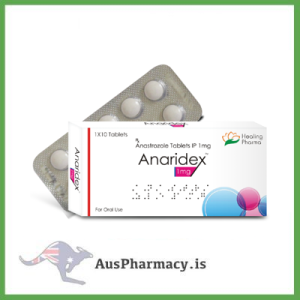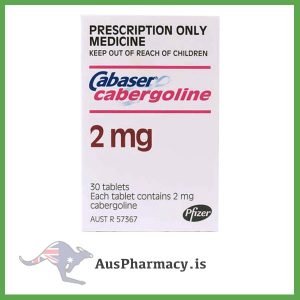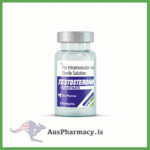Aromasin (Exemestane): Educational Insights into Aromatase Inhibitors and Hormonal Regulation
Introduction
Aromasin, known chemically as Exemestane, is one of the most studied aromatase inhibitors in modern pharmacology. Its mechanism, which involves the irreversible inhibition of estrogen synthesis, provides an excellent case study for understanding endocrine regulation, hormonal balance, and pharmacodynamic control in the human body.
From an educational perspective, Exemestane offers students and researchers a powerful model to explore how enzyme inhibition affects hormonal pathways, particularly the conversion of androgens to estrogens.
This educational article delves into the pharmacological foundation of Aromasin (Exemestane), focusing on its mechanism of action, scientific importance, and academic applications in pharmacology and biomedical learning.
1. Overview of Aromasin (Exemestane)
Exemestane is classified as a steroidal aromatase inhibitor, structurally similar to the natural substrate androstenedione. It binds permanently to the aromatase enzyme, leading to irreversible deactivation — a process often referred to as suicidal inhibition in pharmacology.
In educational settings, this compound is discussed for its ability to demonstrate how enzyme blockade can control hormone synthesis, making it an invaluable teaching tool in biochemical pharmacology.
2. The Science of Aromatase and Estrogen Production
Aromatase is an enzyme complex found in various tissues, including the ovaries, testes, liver, and adipose tissue. Its role is to catalyze the conversion of androgens (like testosterone) into estrogens (such as estradiol).
Exemestane serves as a model molecule for studying how enzyme inhibition can disrupt this pathway, helping students visualize feedback regulation within the hypothalamic-pituitary-gonadal (HPG) axis.
Educational analysis often focuses on:
-
Aromatase enzyme function and structure
-
The conversion process of steroid hormones
-
The implications of enzyme inhibition in hormone balance
3. Mechanism of Action (Academic Perspective)
Aromasin acts by permanently binding to the aromatase enzyme’s active site, effectively preventing it from converting androgens into estrogens. This process results in a significant reduction of circulating estrogen levels.
In academic pharmacology, this mechanism is studied under the concept of irreversible enzyme inhibition, helping students understand:
-
Covalent enzyme-drug interactions
-
Kinetic properties of irreversible inhibitors
-
The difference between competitive and non-competitive inhibition
4. Pharmacokinetics and Absorption
Educational discussions often include how Aromasin is absorbed, metabolized, and excreted in the body.
-
Absorption: Rapid following oral administration
-
Metabolism: Hepatic (primarily through CYP3A4)
-
Half-Life: Approximately 24 hours
-
Elimination: Mostly via the liver
These details allow pharmacology students to appreciate how drug metabolism and clearance affect therapeutic performance and dosing frequency.
5. Educational Value in Pharmacology Programs
Aromasin is commonly integrated into endocrine pharmacology curricula to demonstrate:
-
The relationship between enzyme inhibition and hormone control
-
Clinical pharmacology of aromatase inhibitors
-
Molecular mechanisms of steroid regulation
Through laboratory simulations or academic discussions, students explore how selective enzyme inhibition contributes to therapeutic pharmacology and drug design research.
6. Relevance in Endocrine System Education
Understanding Exemestane helps students comprehend the endocrine feedback loop between estrogen, testosterone, and pituitary hormones such as FSH (follicle-stimulating hormone) and LH (luteinizing hormone).
This balance is central to teaching topics like:
-
Hormonal synthesis and feedback regulation
-
Impact of enzyme inhibition on endocrine signaling
-
Homeostatic mechanisms controlling reproductive hormones
7. Educational Comparison with Other Aromatase Inhibitors
Aromasin (Exemestane) is often compared academically with Anastrozole and Letrozole, two non-steroidal aromatase inhibitors.
Students learn that:
-
Exemestane causes irreversible inhibition, while Anastrozole and Letrozole act reversibly.
-
Exemestane mimics natural androgens, contributing to its strong binding affinity.
-
The pharmacological outcomes differ due to distinct enzyme-binding dynamics.
These comparisons enrich understanding of drug classification, enzyme specificity, and therapeutic optimization.
8. Research Applications and Educational Insight
Exemestane’s educational relevance extends into biomedical research and drug-discovery training.
Researchers use it to study:
-
Mechanisms of estrogen suppression
-
Hormonal interplay in tissue development
-
Potential new aromatase inhibition strategies
For students, studying Exemestane reinforces critical thinking in molecular pharmacology and drug mechanism evaluation.
9. Pharmacological Effects on Estrogen Levels
Exemestane reduces estrogen concentrations by over 85% when studied in controlled environments.
This measurable effect allows students to analyze quantitative pharmacodynamics — the dose-response relationship between drug concentration and biological effect.
Through such analysis, learners develop skills in:
-
Hormone measurement techniques
-
Interpreting pharmacodynamic data
-
Understanding endocrine suppression models
10. Integration into Post-Cycle Educational Models
In educational simulations, Aromasin is sometimes used to illustrate post-cycle hormone recovery mechanisms, demonstrating how the body’s hormonal balance can be restored after exogenous hormone administration.
This area of study is critical for understanding negative feedback suppression and recovery strategies used in hormonal pharmacotherapy and physiological restoration education.
11. Structural and Chemical Analysis
The molecular structure of Exemestane, C20H24O2, includes a modified androstenedione skeleton with a methylene group replacing a carbonyl oxygen.
Students in medicinal chemistry explore how this structural modification gives Exemestane its irreversible binding property — a crucial lesson in structure-activity relationship (SAR) design.
12. Pharmacovigilance and Academic Safety Discussions
In pharmacology training, safety considerations are always part of the educational context.
Students study documented pharmacological responses, including:
-
Fatigue
-
Headache
-
Transient dizziness
These discussions promote responsible understanding of dose dependency, risk management, and ethical pharmacological study design.
13. Ethical and Regulatory Considerations
In Australia and globally, Exemestane is a prescription-only medicine, which provides a strong framework for teaching ethical prescribing, regulatory policy, and pharmaceutical governance.
Academic programs emphasize the need for proper medical supervision, research ethics, and legislative awareness when studying regulated compounds.
14. Technological Integration in Learning
Modern pharmacology education uses virtual simulations and AI-based learning tools to model Exemestane’s mechanism of action.
Students visualize how aromatase enzymes are inhibited in real time, enhancing comprehension through digital interactivity.
This interactive approach bridges the gap between theory and practical understanding of molecular pharmacology.
15. Conclusion
From an educational standpoint, Aromasin (Exemestane) stands as a cornerstone in understanding hormone synthesis, enzyme inhibition, and endocrine pharmacology.
Its ability to irreversibly block aromatase enzymes makes it an exemplary model for teaching biochemical pathways, pharmacokinetic behavior, and therapeutic strategy design.
In pharmacology programs, Exemestane represents the perfect integration of molecular science, clinical relevance, and academic learning, empowering students to connect complex biological systems with practical pharmaceutical principles.
Through responsible education and ethical research, Exemestane continues to serve as a valuable learning tool in the evolving landscape of medical and pharmacological sciences.









